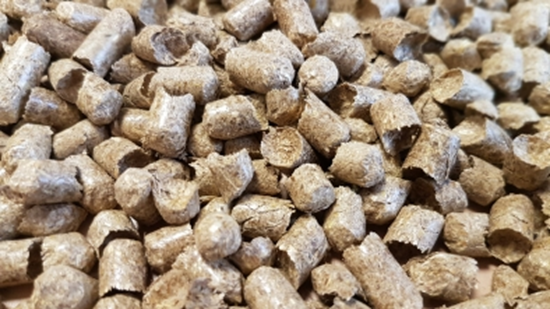The bedding materials most used in Australia are shavings (soft and hardwood), sawdust, cereal straw and rice hulls. The amount used by different chicken production regions varies with availability and cost. Watson and Wiedemann (2018) surveyed the industry and found that the use of sawdust, shaving and rice hulls has decreased, while the use of straw and other bedding types has increased since Runge et al. (2007) reported their levels. Pelletised straw is used as a bedding material in some areas (see Figure 4). A summary of commonly used materials and their properties is provided in Table 2.

Table 2. Properties of the four most common bedding materials used in Australian meat chicken farms (from Watson and Wiedemann, 2018)
| Bedding material | General properties and description | Moisture exchange | Chicken health and performance | Spent litter uses | Practical and economic considerations | Positives | Notes | References |
|---|---|---|---|---|---|---|---|---|
| Wood shaving | Lightweight Medium particle size Soft and compressible Low thermal conductivity | Highly adsorbent yet can dry rapidly | Excellent | Useful as a fertiliser in Australia | Regional availability Supply has been affected by wood industry mills | Considered by many as the best bedding material | Preferred bedding material but becoming limited in supply and expensive in some areas | Ritz et al. (2017), NSW Agriculture (2004), Atencio et a. (2010), Benabdeljelil and Ayachi (1996), Grimes et al. (2007), Villagra et al. (2011), Villagrá et al. (2014). |
| Sawdust | Lightweight Small particle size Soft and compressible Low thermal conductivity | Highly adsorbent yet can dry rapidly | Excellent, but may be supplied wet and may be susceptible to Aspergillus if stored improperly prior to use | Useful as a fertiliser in Australia | Regional availability | A good bedding material when available | Often high in moisture and susceptible to dangerous mould growth if stored improperly prior to use | Singh and Sharma (2000) Ritz et al. (2017), NSW Agriculture (2004), Hafeez et al. (2009), Benabdeljelil and Ayachi (1996). |
| Rice hulls | Lightweight Medium particle size Low thermal conductivity | Lower water adsorbency, large surface area, dries rapidly | Excellent | Useful as a fertiliser in Australia | Regional availability Dependent on rice crop yields | A good bedding material when available | A good bedding material but availability is regional and variable | Ritz et al. (2017), Singh and Sharma (2000), NSW Agriculture (2004), Swain and Sundaram (2000), Atencio et al. (2010), Benabdeljelil and Ayachi (1996), Villagrá et al (2014). |
| Straw- chopped | Lightweight Medium particle size Soft and compressible Low thermal conductivity | Susceptible to caking, which limits moisture exchange when not diligently managed | Excellent, provided caking issues are sufficiently managed May be susceptible to Aspergillus if not appropriately dried and stored prior to use | Useful as a fertiliser in Australia | Regional availability | Large supply in most regions Good bedding material when managed properly | Caking problems Chicken contamination problems Susceptible to mould growth | Ritz et al. (2017), Singh and Sharma (2000), NSW Agriculture (2004), Hafeez et al. (2009), Benabdeljelil and Ayachi (1996), Villagrá et al. (2014), Avdalovic et al. (2017). |

